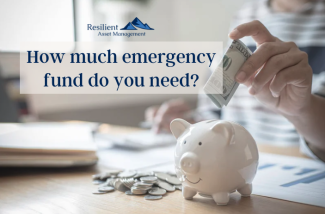
Prepare for a Rainy Day (Part 2) - The Size of your Emergency Fund
Last time I discussed the importance of have an Emergency Fund (read Part 1 here). This time, I will talk about determining the size of your Emergency Fund. Up front, I recommend using conservative estimates and rounding up as emergencies tend to be a bit more expensive than we would otherwise like. And remember, I cannot emphasize enough the importance of having accessible Emergency Cash.
The following are a set of considerations, which are general in nature – everyone’s considerations will be unique:
- The Saver’s employment situation. This can range from a somewhat lower, though guaranteed salary (think military members) to full-commission positions (think headhunters and sales people). The variability and reliability of one’s income is a critical input to the Emergency Fund. Also, if the Savers are a dual-income family, there is actually a greater need for an Emergency Fund as the dual-income family does not have the option of the non-earning spouse entering the work force, thus the combined earning have to be reserved for.
- The Saver’s family situation. Are there multiple children or elderly parents for whom to provide? Are there special needs situations? Are there multiple residences (i.e. a vacation home) to support? This is by no means an exhaustive list…remember to consider ALL commitments.
- The Saver’s monthly expenses. Is there a mortgage payment? Are you paying for private school or college? What is the monthly discretionary allotment? And most importantly, what expenses can be curtailed if necessary?
- The Saver’s existing asset base. Clearly, a multi-millionaire has different considerations than a middle-class worker with only a 401(k) plan and a bit of home equity. Whatever the case, one can consider the Saver’s asset base when deciding on the size of an Emergency Fund. The more disposable cash a portfolio can generate, the smaller an Emergency Fund needs to be.
The above questions are necessarily subjective and we use them to arrive at an objective number, measured in months of living expenses. For my Clients, the nature of employment is the largest influence on the size of the Emergency Fund. Asset base is second and age is third. The following are very broad employment classifications representative of a fair bit of workers. I will explain how I arrive at the Emergency Fund amount for each sub-set.
Case #1: The Very High Earner
High earners are typically (not always) high spenders. Moreover, high earners have income that may vary substantially. For example, compare the variability of a career municipal employee to a restaurant franchisee. Therefore, high earners might need up to 18 months of living expenses to insulate themselves from the hazards of lost, or decreased, income.
Case #2: The Variable Income Earner
I am speaking of those in sales or some other commission-type jobs. You may earn a great deal some years, though in others you might struggle. For folks in this situation, 12 months living expenses might be the answer. If you work on a monthly draw, then the Emergency Fund can be used to smooth your monthly budget each month with paid commissions replenishing the Emergency Fund.
Case #3: The Salaried Income Earner
Think people with relatively (perhaps guaranteed) jobs that while not as high paying as the previous two examples, are as certain as an employment situation can be – think military members. For these folks, a comparatively small Rainy Day Fund of between 3 to 6 months might suffice while the employment situation is static. However, while one contemplates a career change (i.e. military retirement), the need for a larger Emergency Fund increases, perhaps significantly.
Case #4: The Retiree
By definition, Retirees are no longer working, so passive income sources are the most important here. Those with defined benefit pensions (think Military Retirees), income producing real estate, annuitized revenue streams, or other passive investments will need considerably less in reserve than those with only Social Security as income. Additionally, the nature of Long Term Care coverage is a huge (Yuuuge) influence on the Emergency Reserve. Retirees may be responsible for elimination periods on their Long Term Care policies of up to 180 days depending on the policy. For retirees in general, somewhere between 3 and 12 months of living expenses ought to suffice. Admittedly, this is a wide gate; however, every retiree’s circumstances are vastly different…thus the importance of speaking to a Financial Planner prior to retiring.
The Emergency Fund need not be completely fixed. Rather, it should be malleable based on the evolving circumstances of the individuals (or couples). For example, when your last child graduates from college or your start receiving a military pension in your early 40s, your Emergency Fund could go from 12 months down to 6. The idea here is to use reasonable heuristics to arrive at a number with which you are comfortable.
The second order effect of Emergency Funds, with the practical luxury of paying for contingencies being the first order impact, is the comfort provided so one does not feel compelled to tap Long-Term assets (think stocks). By their nature, Long-Term assets are highly volatile, though they do have a higher long-term expected value. The goal is to utilize Long-Term assets at times of your own choosing rather than when forced upon you.
We have now covered the need for the Emergency Fund and how to determine its size. Next time we will talk about some techniques to accumulate the Emergency Fund.



